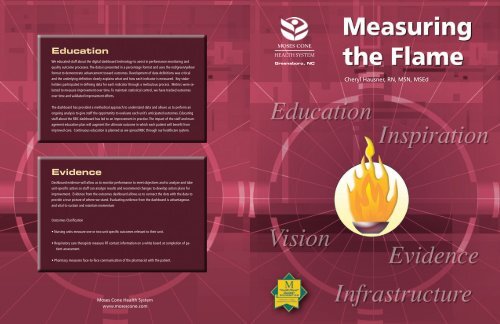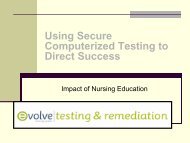Hausner, Cheryl - IUPUI
Hausner, Cheryl - IUPUI
Hausner, Cheryl - IUPUI
- No tags were found...
Create successful ePaper yourself
Turn your PDF publications into a flip-book with our unique Google optimized e-Paper software.
201124C:Layout 1 7/20/09 10:23 AM Page 1EducationWe educated staff about the digital dashboard technology to assist in performance monitoring andquality outcome processes. The data is presented in a percentage format and uses the red/green/yellowformat to demonstrate advancement toward outcomes. Development of data definitions was criticaland the underlying definition clearly explains what and how each indicator is measured. Key stakeholdersparticipated in defining data for each indicator through a meticulous process. Metrics were selectedto measure improvement over time. To maintain statistical control, we have tracked outcomesover time and validated improvement efforts.MOSES CONEHEALTH SYSTEMGreensboro, NC<strong>Cheryl</strong> <strong>Hausner</strong>, RN, MSN, MSEdThe dashboard has provided a methodical approach to understand data and allows us to perform anongoing analysis to give staff the opportunity to evaluate each unit’s anticipated outcomes. Educatingstaff about the RBC dashboard has led to an improvement in practice. The impact of the staff and managementeducation plan will augment the ultimate outcome in which each patient will benefit fromimproved care. Continuous education is planned as we spread RBC through our healthcare system.EvidenceDashboard evidence will allow us to monitor performance to meet objectives and to analyze and takeunit-specific action so staff can analyze results and recommend changes to develop action plans forimprovement. Evidence from the outcomes dashboard allows us to connect the dots with the data toprovide a true picture of where we stand. Evaluating evidence from the dashboard is advantageousand vital to sustain and maintain momentumOutcomes Clarification• Nursing units measure one or two unit specific outcomes relevant to their unit.• Respiratory care therapists measure RT contact information on a white board at completion of patientassessment.• Pharmacy measures face-to-face communication of the pharmacist with the patient.Moses Cone Health Systemwww.mosescone.com
201124C:Layout 1 7/20/09 10:23 AM Page 2SummaryVisionInspirationInfrastructureThe Results Council is the dynamicdriving force of our RelationshipBased Care initiatives.Made up of diverse membersrepresenting all disciplines andlevels of employees across theorganization, the Council isunited by its shared vision forexcellence and commitment toliving the principles of RelationshipBased Care. Creative andunique approaches support ourimplementation strategy to createa powerful culture of caringand healing.The vision for the Results Council at ourorganization was to bring together agroup of the most diverse, creative, anddynamic leaders in our System. Weneeded this group to commit to takinga journey together to transform patientcare in a way that would dramaticallyand significantly affect their livesand ours.Executive leadership identified and invitedleaders to participate in our transformationaljourney. We held a two-daykickoff meeting to share the vision ofRBC as the care delivery model for theorganization. Education included thedefinition of RBC, its importance andanticipated benefits -- including its linkto the organization’s mission, vision,values and strategic plan. Inspirationand excitement for the journey was createdthrough Council group activitiessuch as reading and discussing RelationshipBased Care: A Model for TransformingPractice, the ImplementationGuide for Relationship Based Care, andby watching videos about RBC.The first agenda item at all ResultsCouncil meetings is a celebration ofour successes with RBC. Council membersshare stories about relationships,excellence in patient care and positiveoutcomes. These stories reinforce theimportance of inspiration and appreciationand keep the Council energized. Athree-day leadership training experiencewas designed by members of ourResults Council to rediscover the spiritof leadership and assure that all leadersacross the System are on boardwith the RBC vision. All of our organization’sleaders attend this energizingretreat. Results Council members activelyparticipate in all status checkmeetings and celebrate the successesof each unit practice council. ResultsCouncil members round regularly on alldepartments in each wave, using appreciateinquiry strategies.Strong support from our Executive Leadership was the initial driving force for a successful start to the change process. Their message wasclear this was an important endeavor we are undertaking -- and it is critical to have commitment from Results Council members from differentdepartments and disciplines. The Council then divided into eight functional groups and each group leader from the Results Council identifiedand invited key individuals from across the organization to join them. These functional groups are: Education, Communication, Outcomes,Service Support Physician Collaboration, Caring/Healing, Integration and Coordination. Members were educated about RBC and the accountabilitiesof their groups. Each group developed and submitted 18-month strategic plans. To enhance communication and a common focus, theCouncil designed a Web site for posting all resources and documents related to RBC that is easily accessed by all employees. The members developedan elevator speech, which was posted on the Web site and communicated across the organization. The Council approved thePrinciplesfor all caregivers and posted them on the site. After recognizing the need to have a link between the Results Council and unit practicecouncils, liaisons were appointed from the Results Council. Liaisons attend unit practice meetings and coach and mentor staff in developingand implementing plans to achieve the principles. Liaisons give reports about unit practice council activities, accomplishments and challengesat each Results Council meeting. The Results Council meets monthly to review subgroup progress and to develop action plans identified bysubgroups and liaisons. At the department level, each practice council developed an RBC vision statement to be integrated into the daily operationsof each department, providing a common purpose for employees. And finally, we have recognized the need to have one individual coordinatethis change process, particularly as we expand our implementation to five sites. Therefore, we recently named our firstRelationship-Based Care Coordinator.
















